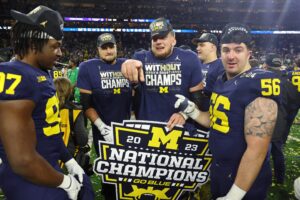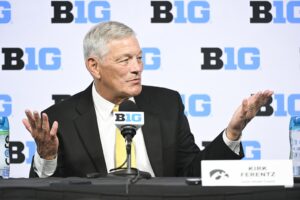As we approach the NFL draft, there are people spreading myths about Justin Fields.
The Ohio State quarterback has been considered one of the best prospects in college football for the last two years. But since the NFL Draft is a season of information manipulation, Fields is the victim of these practices.
First of all, Dan Orlovsky of ESPN appeared on The Pat McAfee Show and shared some of what he heard about Fields. According to “people that are going to at least be associated with decision making,” voiced concerns about Fields’ work ethic. They said Fields was a “last guy in, first guy out type of quarterback,” with regards to practice, and questioned his desire to be a great quarterback.
The second time the media spread myths about Fields was when ESPN’s Todd McShay appeared on First Take. McShay said “a team” found that of Fields’ 225 pass attempts in 2020, only seven went to a receiver beyond his first read.
McShay and others believe that Fields can’t move through progressions, largely due to his poor performance against Northwestern in the Big Ten Championship Game. His favorite receiver, Chris Olave, was out for that game and Fields couldn’t seem to find an open receiver.
Both statements about Fields are myths, which can be easily disproven.
Dispelling The Myths About Justin Fields
The two knocks on Fields are that he doesn’t have a strong work ethic, and that he can’t read through progressions.
Both are manufactured out of either an NFL team wanting to hurt his draft so he falls to them in the draft or out of a failure to watch the film. Either way, they are both completely false, and we will address them one by one.
Myth 1: “Last guy in, first guy out.”
Ohio State Head coach Ryan Day gave a clear, step by step argument about why this absolutely and utterly false. Day said that Fields worked so hard, he even inspired the strength and conditioning coach Mick Marotti.
But let’s say that Day is painting Fields in a positive light to protect his own program. There are two assertions that Day made that are visible to everyone outside of Columbus.
Fields Fought To Play
When the Big Ten cancelled fall sports, several big names like Micah Parsons and Rashod Bateman decided to prepare for the upcoming draft. In fact, other projected first round picks, like Caleb Farley and Ja’Marr Chase opted out, even when their conferences decided to keep playing.
Fields was a projected first rounder, and was considered one of the top quarterbacks in college football. He could have opted out, or starting preparing for the draft since there would be no season.
He not only fought to bring football back to the Big Ten, he became the face of the movement.
Some ask “where is his desire to be a great quarterback?”
Fields fought to play an extra season of a violent sport in the middle of a global pandemic. He could have opted out and secured millions of dollars. But he chose to risk it because he did have the desire to be great.
The interesting thing is that Chase is projected to be a top-five pick in the draft despite opting out of the 2020 season. Yet no one questions his work ethic. No disrespect to those who opted out, but it makes no sense to question Fields’ work ethic when he took a harder road than others.
On The Field
Those who question Fields’ work ethic have clearly never watched him play. Fields is one of the toughest quarterbacks in the draft, evidence by his competition on the field. He never shied away from big hits, even the ones that sent him to the bench.
In the game against Michigan in 2019, Fields suffered an injury to his plant leg and had to be examined in the medical tent. He came back later in the drive, and his first play back was a 30-yard touchdown pass.
He played through a through injury against Northwestern in the 2020 conference championship. Fields thought he sprained his thumb, and underwent an X-ray after the game. Though it affected his throwing abilities, but he didn’t miss a snap.
Then there was the hit against Clemson. Fields took a shot to the ribs and had to go to the tent. Once again, Fields was back just a few plays later and delivered a strike for a touchdown.
If the greats play through the pain, then Fields has to be considered among them.
Myth 2: Fields is a One Read Quarterback
Again, this criticism of Fields is totally inaccurate. Scouts might arrive at this conclusion after only a surface level of analysis, but this argument is debunked after a closer look.
It’s Not Necessarily A Problem
First of all, being a “one read guy,” isn’t inherently a bad thing.
There’s a reason that a certain player is the first read. That’s the receiver that the play is designed to help get open. Ideally, the quarterback should be able to throw to his first read 100 percent of the time.
If this was a valid concern for NFL decision makers, then they should look inside their own organizations. There are several NFL quarterbacks who try to stick to their first read, like Kirk Cousins and Jared Goff. Yet, that didn’t stop the NFL from dishing out millions upon millions of dollars for their services.
Yet Mac Jones, who McShay mocked to go eight spots ahead of Fields in the draft, threw half of his passes on screens at the line of scrimmage. That means on 50 percent of Jones’ passes, his second read was the turf. But that doesn’t hurt his draft stock the way it hurts Fields’.
It’s only a problem if Fields throws to his first read when that option is covered. That’s not a problem for Fields, as we will see below.
This Argument Is Factually Untrue
McShay said “a team” found that Fields only threw past his first read seven times all season. McShay would do well to question the validity of this team, because the information they gave him was false.
Christian Williams of The Cut charted four games of Fields’ progressions, and found numbers that directly contradict McShay’s.
While McShay asserted Fields only threw the ball to secondary or tertiary options seven times (or on 99.97 percent of his passes), in each of the four games Williams charted, Fields did that no less than eleven times in each game. Out of the 133 passes thrown in those games, only 86 of them (61 percent) went to the first read.
While this metric doesn’t measure the whole season, the discrepancy between McShay’s team and Williams is astounding.
If a more reliable source is necessary, Pro Football Focus found that Fields was the most accurate quarterback in college football when throwing past his first read. The minimum threshold for this metric was 60 passing attempts. Not only did Fields make it past his first read, he was more accurate than anyone else when he did.
There’s no question that Fields is a top-five pick in the draft. He is as physically gifted as anyone else and has the maturity and IQ he needs to succeed in the NFL. The things being spread about him are rumors to deliberately plummet his draft stock. The smart NFL decision makers will be able to cut through the falsehoods and see the opportunity they have to add a great player to their team.






